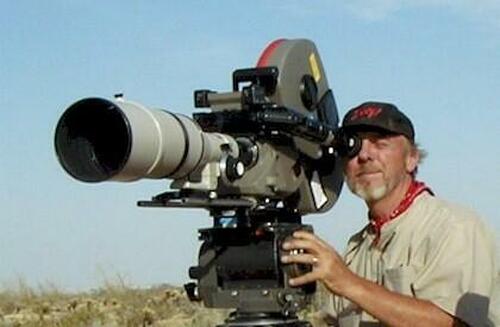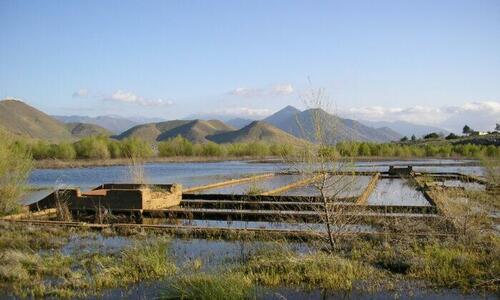Ghost Towns Resurfacing As Lakes Recede Amid Worsening Western Drought
Authored by Allan Stein via The Epoch Times (emphasis ours),
Every two or three years, Lake Isabella’s shoreline pulls back almost like clockwork, and the former town of Old Kernville, California, rises from its watery grave to reveal its crumbling skeleton.
Retired Hollywood cinematographer Chuck Barbee has watched the lake give up its famous ghost town many times with interest.
The main difference today, he said, is that the abandoned town, once known as Whiskey Flat, has been exposed far longer than usual. Part of it is due to dam activity and the western drought that began in 2000.
“The town itself is fascinating. It has quite a history,” said Barbee, who lived in the town next door, which became the new Kernville, as a teenager and later moved back after a long career in movies and television.
While Old Kernville is one of several ghost towns to resurface in the increasingly arid southwest, it is perhaps the most colorful.
Years ago, movie giants like John Wayne, Roy Rogers, and Gene Autry made westerns in the dirt streets of Old Kernville. Hollywood movie moguls would produce more than 400 westerns here, from the silent movie era until the town pulled up stakes in the 1950s to make way for the Lake Isabella reservoir.
In those early cinematic days, the town thrived with cattle ranches and cowboys. The school and church bells rang, and the 19th-century gold rush town was vibrant and prosperous. It even had a hotel for movie actors and staff.
Better still, Old Kernville was a mere three-hour drive from Hollywood, which made it the perfect venue for western movie productions operating on a budget.
“John Wayne shot some river crossings from the movie ‘Stagecoach’ here,” Barbee said. “The attraction of Kernville as a movie place is simple: This was a relatively authentic old west town with dirt roads until the ’30s and hitching posts. It was a real [western] town.”
What Lies Beneath
About 360 miles to the northeast lie the adobe and concrete ruins of Old St. Thomas in Clark County, Nevada, one of the state’s earliest Mormon communities.
For decades, the town lay buried under 70 feet of water at Lake Mead, a 247-square-mile artificial reservoir on the Arizona-Nevada border.
Replenished by the Colorado River, the reservoir supplies an estimated 25 million people with drinking water. However, the lake’s surface has fallen to a historic low since the drought began 22 years ago as the reservoir approaches failure level.

What’s left of the old frontier settlement, founded in 1865, is an eerie landscape of forgotten building foundations, sealed wells, and grey tree stumps lining the former Main St.
Scattered about the rocky terrain are random parts of early vintage automobiles, including rusty engine blocks and brake components.
The U.S. National Park Service maintains the site through the Lake Mead National Recreation Area.
During its heyday, Old St. Thomas was a desert oasis community of about 500 inhabitants who earned their living farming, ranching, and mining.
They made the desert flourish by irrigating the land and planting tall shade trees throughout the town center, complete with a general store and cafe, a church, a school, and quaint homesteads. The San Pedro and Los Angeles Railroad ran from Moapa to St. Thomas, laden with commercial goods.
The residents endured extreme heat, drought, illness, and economic hardship, abandoning the town with the construction of the Hoover Dam and the rising Colorado River and flooding that followed. The last known resident, Hugh Lord, left on June 11, 1938.
Former residents would later return and hold reunions in memory of their pioneer roots.
At the 1965 gathering, former U.S. Sen. Berkeley Bunker (D-Nev.), “wearing a beat up old hat, told the crowd that he had buried his hat next to his house as the lake rose in the 1930s,” the Lake Mead National Recreation Area wrote in a historical guide.
“On the morning of the reunion, he dug it up [from an exposed location] and plopped it on his head.”
Lying 400 miles to the north is the abandoned ghost town of Rockport, Utah, which sat underwater for more than 60 years, resurfacing in 2021 amid the worsening drought and receding Rockport Reservoir.
Rockport’s population peaked at around 200 residents after the first settlers arrived in 1860, according to Utah State Parks. All that remains are the faint outlines of old building foundations and unpaved roads.
Wet Fate for a ‘Dry’ Town
Old Kernville was originally named Whiskey Flat after a saloon opened in the previously “dry” town. Years later, residents changed its name to the more civilized Kernville in 1864.
Barbee said the town had everything that appealed to a producer of western movies: dirt roads, a saloon, faux and authentic storefronts bookended by actual buildings, genuine ranchers, and free-range cattle.
“They had a hotel they built for the movie business called the Mountain Inn,” said Barbee, director of photography for the early 1980s sitcom “Night Court.”
“They had their movie street. If you have ever watched a ‘B’ western [made] in Kernville, the town has appeared in hundreds of movies. Roy Rogers shot here regularly—Gene Autry.”
Barbee told The Epoch Times, “One phone call and a production manager could call one rancher up here. He would give you whatever you needed. A herd of cattle? They’ll be there. Rangers? We got them. Stagecoaches? Whatever. This one guy could provide it all.”
If a movie script required a rolling river and the rugged southern Sierra mountains, “Kernville was the place,” Barbee said.
But not even the town’s strategic location and popularity could save it in the end, and in 1950 the residents began vacating to make way for the Lake Isabella reservoir and dam construction project.
Barbee said the town eventually disappeared under about 20 feet of water, reappearing every two or three years with the dams’ operation and seasonal dry spells and then sinking back into history.
Read more here…
Tyler Durden
Sat, 10/15/2022 – 13:30
via ZeroHedge News https://ift.tt/qdADkXu Tyler Durden



